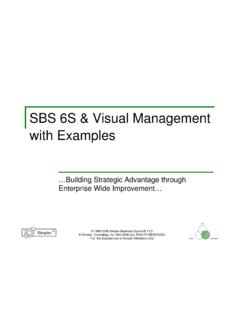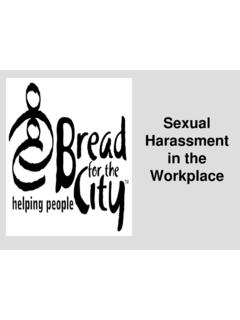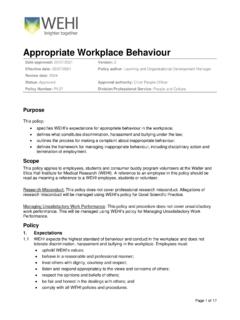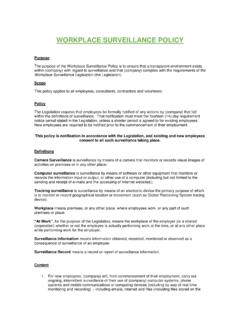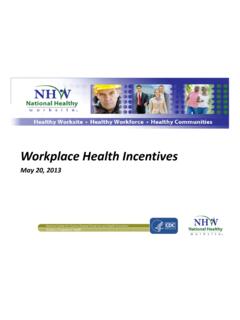Transcription of Lessons Learned Solutions for Workplace Safety and Health
1 Lessons Learned Solutions for Workplace Safety and Health David Kriebel, Molly M. Jacobs, Pia Markkanen, Joel Tickner with editorial assistance by Nancy Irwin Maxwell Lowell Center for Sustainable Production University of Massachusetts Lowell Lessons Learned Solutions for Workplace Safety and Health David Kriebel, Molly M. Jacobs, Pia Markkanen, Joel Tickner with editorial assistance by Nancy Irwin Maxwell Lowell Center for Sustainable Production University of Massachusetts Lowell J a nu a r y 2 0 1 1. About the Lowell Center The Lowell Center for Sustainable Production is a research center of the University of Massachusetts Lowell working to build healthy work environments, thriving communities, and viable businesses that support a more sustainable world.
2 We do this by working collaboratively with citizens' groups, workers, businesses, and government agencies. Acknowledgments We are deeply grateful to Earl Dotter (shown here at Ground Zero) for permitting us to use his breathtaking photographs of workers. Earl seeks out those who are taking steps to improve their lives at work, and uses the camera to engage them giving visual testimony to their achievements. The images that result tell of the satisfactions of their work as well as its many challenges to their Safety and Health . Please visit Earl's website to view additional images and to learn how to purchase his photos at We are also grateful to the Public Welfare Foundation for its generous support of this project and the dozens of occupational Health experts (too many to mention) that we consulted with as we selected and developed the individual case studies.
3 Ii | Lowell Center for Sustainable Production | University of Massachusetts Lowell Contents Introduction 1. C a s e S t u d y 1. Floor finishers, lacquer sealers, and fires: safer product alternatives are the solution 7. C a s e S t u d y 2. When my job breaks my back: shouldering the burden of work-related 19. musculoskeletal disorders C a s e S t u d y 3. The poison that smells like butter: diacetyl and popcorn workers' lung disease 41. C a s e S t u d y 4. Injuries are not accidents: construction will be safe when it's designed to be safe 59. C a s e S t u d y 5. Regulating methylene chloride: a cautionary tale about setting Health standards 81. one chemical at a time C a s e S t u d y 6. Safe food from safe workplaces: protecting meat and poultry processing workers 99.
4 Conclusions Synthesis & Recommendations 119. Lessons Learned : Solutions for Workplace Safety and Health | iii Going to work should not be a choice between feeding your family and protecting your Health and Safety . iv | Lowell Center for Sustainable Production | University of Massachusetts Lowell introduction Healthy Workplaces Support Healthy Communities M. ost people wor k. Many 1900s, and visionary scientists like Alice Hamilton people do work that is highly hazard- and Irving Selikoff identified occupational Health ous, such as mining, construction, hazards of lead and asbestos, we continue to expose and some manufacturing workers to a wide range of dangerous, yet wholly others work in service industries such preventable, hazards.
5 Going to work should not be as retail or house-keeping, which are not typically a choice between feeding one's family and protect- thought of as hazardous but can still cause seri- ing one's Health and Safety . ous injuries. More than four thousand workers This report, Lessons Learned : Solutions for Workplace in the United States died on the job in 2009 and Safety and Health documents case studies of systemic more than million workers were injured or failures in protecting workers from injury and ill- made ill by their ,2 ness and outlines some paths forward that can We also know that the reported injuries, illnesses more effectively protect workers, the communities and fatalities represent only a small fraction of in which they live, consumers, and the environ- the total work related illnesses and diseases in the ment while stimulating innovation in safer forms United States because of serious under-reporting.
6 Of production. For example, the 4,000 deaths/year counted above don't include the nearly 10,000 asbestos-related A failed regulatory approach to worker Health deaths in the per year a number about In 1970, Congress passed the Occupational Safety which we have a high degree of confidence even and Health Act (OSHAct) to assure so far as though it doesn't come from the official work- possible every working man and woman in the Na- place fatality Failures to protect the tion safe and healthful working conditions. The Health and Safety of workers have tremendous OSHAct was enacted at a time of unprecedented costs for those who are harmed, their families passage of laws for protection of workers and the and their communities.
7 Ignoring the pain and environment. It promised new protections for suffering, the simple economic costs run to the worker Safety and Health including a general duty tens of billions of dollars per year (workers on employers to furnish to each of his employees compensation payments alone accounted for employment and a place of employment which are $ billion in 2008).4,5 free from recognized hazards that are causing or Despite these sobering statistics, improving oc- are likely to cause death or serious physical harm cupational Safety and Health has received little to his employees. Particularly in its first decade, public or political attention in this country. While the Occupational Safety and Health Administra- Upton Sinclair highlighted horrific working con- tion (OSHA) made important contributions to ditions in the meatpacking industry in the early Workplace Health and Safety , but from the Reagan 2010 Earl Dotter Lessons Learned : Solutions for Workplace Safety and Health | 1.
8 Int r o ducti o n : Healthy Workplaces Support Healthy Communities 2010 Earl Dotter administration onwards, the agency and the policies The early recognition of limits in science but it implements have been significantly weakened. the need to act in a precautionary, preventive OSHA has suffered severe reductions of its manner changed with the 1980 Supreme Court funding and effectiveness in implementing and decision striking down OSHA's proposed stan- enforcing Workplace Health and Safety . Early court dard for benzene. The court noted that OSHA. decisions supported OSHA's ability to implement had not demonstrated significant risk with sub- strict prevention-oriented standards even when stantial evidence.
9 The case ushered in a require- the scientific evidence about a particular hazard ment for agencies to quantitatively demonstrate was limited. For example in a case challenging that a hazard represented a significant risk before OSHA's occupational standard for vinyl chloride establishing an occupational Health standard, that (The Society of the Plastics Industry, Inc., v. Oc- the job of OSHA was not absolute Safety but the cupational Safety and Health Administration, elimination of significant harm.. 1975), the Second Circuit Court noted: the ulti- Today, few Health and Safety experts believe that mate facts here in dispute are on the frontiers of OSHA's rulemaking and enforcement activities scientific knowledge and though the factual finger are effectively living up to the goals of the original points, it does not conclude.
10 Under the command act. A short list of failures includes: of OSHA, it remains the duty of the Secretary to Chronic under-reporting of occupational in- protect the working-man, and to act even in cir- jury and illness rates in national surveillance cumstances where existing methodology or re- systems;. search is deficient. The court further stated that An enforcement system based heavily on small regulations can establish standards that require penalties and inspections that never reach the technologies that may be only looming on the vast majority of establishments covered by the horizon. OSHAct;. 2 | Lowell Center for Sustainable Production | University of Massachusetts Lowell The current rules and structure of occupational Safety and Health work against preventive and precautionary measures.








